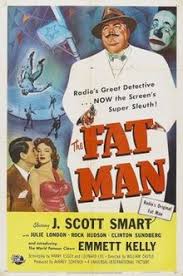
Henry Bromley (Ken Niles) is a dentist from California who is visiting New York City to participate in a conference. He has a new theory on dental bridgework he plans to present. While in his hotel room a man knocks on the door. Dr. Bromley opens the door. He is knocked unconscious; he is given a sedative and thrown out the window plummeting to his death. It looks like an accident.
Dr. Bromley’s dental assistant Jane Adams (Jayne Meadows) discovers his body. The next day she visits private detective Brad Runyan (J. Scott Smart). From his date book Jane sees that Runyan had an appointment with Bromley. Runyan doesn’t know why the dentist wanted to see him. Jane is scared. She feels that the accident wasn’t really an accident and that someone is following her. She plans on returning to California.
Runyan has his assistant, Bill Norton (Clinton Sundberg), take her to the airport. Bill is attacked but Jane gets away. Runyan now believes there is something funny going on. He and Bill go to California to investigate. According to Jane the only thing missing from the dentist’s possessions was an x-ray plate for a patient’s teeth. The patient is Roy Clark (Rock Hudson). In California Jane checks the doctor’s records and sees that the office copy of the x-ray is also missing and so is Clark's patient information card.
Runyan’s investigation turns up Gene Gordon (John Russell), an old friend of Clark’s. Local Police Lieutenant Stark (Jerome Cowan) is well aware of Gordon. He suspects Gordon is involved in illegal activity but has never been able to prove it. Through Gordon’s chauffeur Tony (Robert Roark) he finds Pat Boyd (Julie London), a hostess at a club. Roy and Pat met, fell in love and married. Then Roy disappeared.
The investigation digs deeper and uncovers a major racetrack robbery, murder and extortion.
“The Fat Man” was released in 1951 and was directed by William Castle. It is a crime drama and considered a film noir to some but it doesn’t really play like one. The movie is based on the radio program from the forties and fifties. J. Scott Smart reprises his role from the radio series for the movie as the ever so large detective. Other than some bit parts this was his only starring film credit. Smart died before the film was released. The film is based on characters created by Dashiell Hammett. It is also a little on the obscure side. I doubt that you’ll find it on any top ten noir lists, or even top twenty.
This is not the only noir film that William Castle has to his credit. He also directed four of the Whistler series films starring Richard Dix as well as several other film noir movies such as “Undertow” and “Hollywood Story”. Castle did many noir, mystery and western films before he got into the horror with a gimmick genre.
Reportedly Alfred Hitchcock decided to make Psycho after noting the financial success of 1950s B-movies by Castle and Roger Corman.
How much this movie is noir is up for debate. The camera work is fine but not exactly noir. There are no dark streets or fog or fancy camera angles or shadows. Other than calling everyone sweetheart, the detective isn’t hard-boiled. It does have several flashbacks and even a flashback inside a flashback. Other than that it plays like a regular murder mystery with some noir aspects but, at least to me, it doesn’t have a lot of the usual noir tropes that make a noir film so flavorful. The movie itself is also good but nothing special.
The film also features a very young Rock Hudson and a very young Julie London.
Of more interest is Emmett Kelly. He plays Ed Deets, a former circus clown that was Roy Clark’s cell mate in prison. In the film Kelly is wearing clown make-up that is different than what he normally sports when he is doing his act. Kelly was a circus performer for the Ringling Brothers and Barnum & Bailey Circus. He was one of the clowns that performed for the circus when the tragic 1944 circus fire in Hartford, Connecticut erupted. The fire killed 167 people and injured 700. Kelly was photographed in his hobo clown make-up (Weary Willie) holding a water bucket. The photograph led to the awful event being called “The Day the Clowns Cried”.

